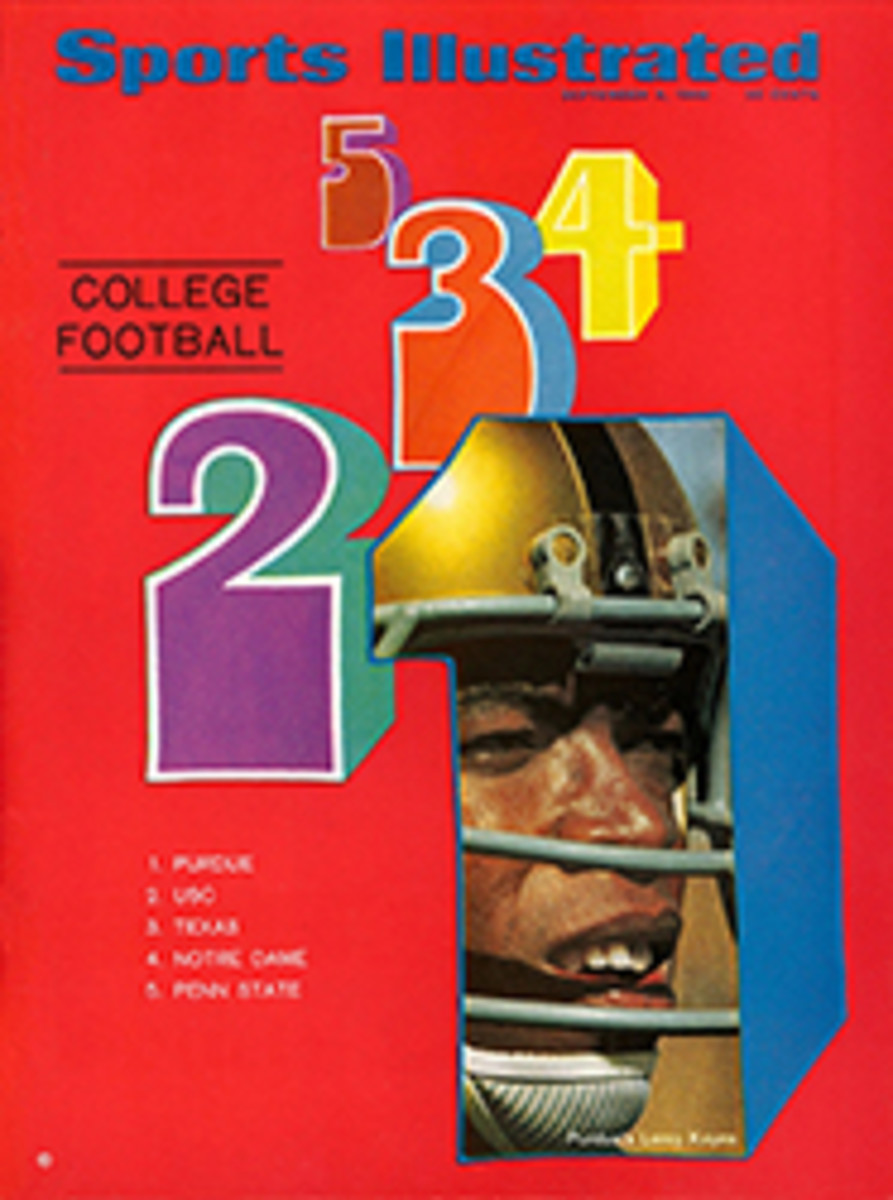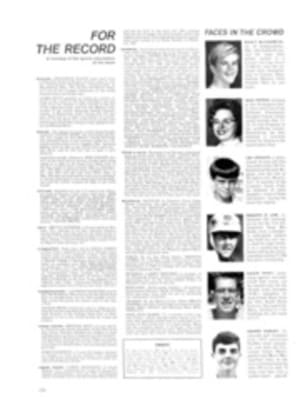
Mr. Clean and his Mustang-eating machine
Most of the time automobile racing can be fun—not fun as in fun and games but fun as in enjoyable. It can also provide laughs, as in comic relief. Occasionally and unfortunately, it can also be laughable, which it was last week at the Continental Divide Raceway at Castle Rock, Col. on the occasion of the 11th race of the Sports Car Club of America's Trans-American series.
In the Trans-Am, now in its third struggling year, there are two classes of cars: one for sports cars with displacement of less than two liters (Porsches, Lancias, Alfa Romeos and the like); the other for cars of up to five liters or 305 cu. in., i.e., the Mustangs and Camaros and Javelins. The latter are the show cars, the ones that are supposed to bring in the crowds, but essentially they are merely little stock cars, and always overshadowing them in the eyes of the public are the big and brutal stockers that run the NASCAR Grand National circuit. What's worse is that except for the Riverside (Calif.) 500, no stock car race of any size has ever really made it big on road circuits, and the Trans-Am series is run on roads. Finally, NASCAR itself has gotten into the sporty-car act with its own "Baby Grand" series for Trans-American type racers. On the South's ovals of under one mile they are actually faster than their bigger brothers, and in a couple of years NASCAR will probably have two distinct circuits—one on the smaller ovals for the Baby Grands and one on the existing superspeedways (plus those being built or planned in Michigan, Alabama and California) for the Grand Nationals.
From the moment the cars first appeared at Continental Divide, a tight, scenic course roughly halfway between Denver and Colorado Springs, it was obvious things were not going to proceed smoothly. First of all, not many cars showed up. Only 18 cars started the race, only five in the big-car division were competitive (two Mustangs, two Javelins and one Camaro) and only 11 finished it, which left a lot of time for quiet, uninterrupted reflection by the scattering of spectators around the 2.66-mile course. The Mercury Cougars, Dodge Darts and Plymouth Barracudas, which lent the series some variety in 1967, did not compete this year, but there is a welcome and surprisingly-strong Javelin team from little American Motors. Had it not been for the Javelin, the big-car part of the Trans-Am would have consisted solely of a fight between factory Mustangs and the lavishly financed Camaros of ex-Driver Roger Penske.
Though the Trans-Am sponsors are still a long way from the kind of success they think they deserve—the time when people owning Camaros, Mustangs and the rest turn out in large numbers to root for their makes—prize money is way up over 1967 and attendance is gaining little by little. The factories are already plenty keyed up, for each victory is a skirmish won in the war for sales in the huge and growing sporty-car market, which should soar to 850,000 this year. In the Trans-Am's first two years the Mustangs won and helped Ford sustain its winner's image as first and biggest in sporty cars. But, Lord, how the Mustangs have been chewed this year by the Penske Camaros! After an initial Mustang victory at Daytona Beach in February, Mark Donohue won eight straight races for Penske to put the championship out of Ford's reach—and helped Camaro to its current level of 147,800 sales for the year. That is a gain of nearly 8% over the same 1967 period; Mustang is down about 25%. The Mustangs also are being challenged for second place in the 13-race series by the uppity Javelins.
In Colorado the Mustang people, trying to salvage something of the season, rented the track on the Friday before the race. All they got for the trouble was a blown engine for regular Driver Jerry Titus and another for Dan Gurney, who had been thrown into the struggle as chief savior.
During the technical inspection that precedes every race, SCCA scrutineer Jim Patterson, a nice guy with an unenviable job, took one look at the front suspension of the Mustangs and saw something weird. Fran Hernandez, the Mustang crew chief, couldn't prove it was legal; but, on the other hand, Patterson couldn't prove it wasn't. In a huff, Hernandez packed up his cars and went to lunch. Meanwhile Patterson also saw something—he wouldn't say what—that "wasn't exactly kosher" about the Javelins and sought out Javelin Team Manager Jim Jeffords. His mission appeared to be a compromise: if Jeffords wouldn't make a fuss about the Mustangs, then Patterson wouldn't make a fuss about the Javelins, and both would race, illegally but peaceably.
"This isn't the way to do things," Patterson said, "but I don't have much choice."
If any of the top five cars—the Javelins driven by Peter Revson and George Follmer, the Mustangs and Donohue's Camaro—were to be eliminated, Promoter Sid Langsam would be in big trouble trying to attract customers. (Ultimately he drew 8,500.)
Hernandez returned from lunch with his Mustangs safely through inspection, put them on the track and blam! blam! Two more engines went up.
After that, the race was anticlimactic. Donohue took the lead on the first turn of the first lap and held it for 78 of the race's 94 laps. Actually there was just one anxious moment. A third of the way through he had to pit to replace a tire that had picked up debris from the abrasive track. As for the newly engined Mustangs, Gurney's blew on the third lap, and Titus, who made a stiff challenge for the lead after Donohue's unscheduled pit stop, blew his on the 76th lap. That brought Ford's engine wipeout score for the week to six.
On the Javelin side, things were not much better. Revson slowed considerably early in the race because of high water temperature and low oil pressure and had to nurse his car the entire afternoon. Follmer fractured a rocker arm two-thirds of the way through to leave the track entirely to Donohue and the Camaro.
But there was still one bit of hilarity left. Follmer's Javelin could at least run, and when Jeffords learned Follmer would be placed sixth in the over-two-liter class if he could finish the race under his own power, he sent Follmer out on Donohue's last lap. When Follmer got on the course he saw Revson parked by the side of the track with a suddenly dead engine and did what any considerate teammate would do—gave Pete a shove to restart Revson's engine so Pete could finish fourth overall and keep Javelin abreast of the Mustangs. There was only one catch; push starts on the course are illegal. In the pits after the race Follmer said, "Maybe I did wrong."
He did. The stewards disqualified Revson from fourth place, which moved Follmer into fifth, and since an independent Mustang driven by John McComb finished third, Javelin fell four points behind Mustang in the season's standings in their duel for second place. Fred Baker continued Porsche's dominance of the under-two-liter division.
Nothing should be taken from Donohue, nicknamed "Mr. Clean" in honor of his cherubic face and boot-camp haircut, and Penske, the driver turned owner, for their victory. Donohue, a mechanical engineer out of Brown University, in half a dozen years has moved to the forefront of U.S. road racing without fuss or fanfare, much in the way Penske did before him. The Castle Rock win was their ninth in the series, and they really did not have to show up at all. "We did it just to try and keep the series alive," Penske said.
For their efforts, Penske and Donohue continued to enjoy one of the most successful years of sports-car racing ever. Earlier Donohue had won the U.S. Road Racing Championship for the second straight year in a Penske car and en route five of the nine races in that series, which is a sort of preliminary to the more prestigious and infinitely richer Canadian-American Challenge Cup series that began on Sunday at Elkhart Lake, Wis.
"If we win that," Penske said, "all that will be left for us is volleyball."
And unless things improve drastically, that might be all that will be left for the Trans-Am people as well.
PHOTO
WHAT, DONOHUE WORRY? THE WINNER YAWNS THROUGH BRIEFING WITH DAN GURNEY (LEFT) AND GEORGE FOLLMER

